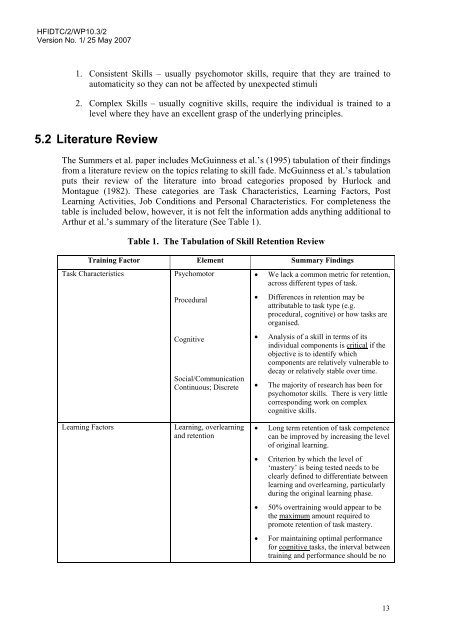Literature Review on Skill Fade - Human Factors Integration ...
Literature Review on Skill Fade - Human Factors Integration ...
Literature Review on Skill Fade - Human Factors Integration ...
Create successful ePaper yourself
Turn your PDF publications into a flip-book with our unique Google optimized e-Paper software.
HFIDTC/2/WP10.3/2<br />
Versi<strong>on</strong> No. 1/ 25 May 2007<br />
1. C<strong>on</strong>sistent <strong>Skill</strong>s – usually psychomotor skills, require that they are trained to<br />
automaticity so they can not be affected by unexpected stimuli<br />
2. Complex <strong>Skill</strong>s – usually cognitive skills, require the individual is trained to a<br />
level where they have an excellent grasp of the underlying principles.<br />
5.2 <str<strong>on</strong>g>Literature</str<strong>on</strong>g> <str<strong>on</strong>g>Review</str<strong>on</strong>g><br />
The Summers et al. paper includes McGuinness et al.’s (1995) tabulati<strong>on</strong> of their findings<br />
from a literature review <strong>on</strong> the topics relating to skill fade. McGuinness et al.’s tabulati<strong>on</strong><br />
puts their review of the literature into broad categories proposed by Hurlock and<br />
M<strong>on</strong>tague (1982). These categories are Task Characteristics, Learning <strong>Factors</strong>, Post<br />
Learning Activities, Job C<strong>on</strong>diti<strong>on</strong>s and Pers<strong>on</strong>al Characteristics. For completeness the<br />
table is included below, however, it is not felt the informati<strong>on</strong> adds anything additi<strong>on</strong>al to<br />
Arthur et al.’s summary of the literature (See Table 1).<br />
Table 1. The Tabulati<strong>on</strong> of <strong>Skill</strong> Retenti<strong>on</strong> <str<strong>on</strong>g>Review</str<strong>on</strong>g><br />
Training Factor Element Summary Findings<br />
Task Characteristics<br />
Psychomotor<br />
• We lack a comm<strong>on</strong> metric for retenti<strong>on</strong>,<br />
across different types of task.<br />
Procedural<br />
Cognitive<br />
Social/Communicati<strong>on</strong><br />
C<strong>on</strong>tinuous; Discrete<br />
• Differences in retenti<strong>on</strong> may be<br />
attributable to task type (e.g.<br />
procedural, cognitive) or how tasks are<br />
organised.<br />
• Analysis of a skill in terms of its<br />
individual comp<strong>on</strong>ents is critical if the<br />
objective is to identify which<br />
comp<strong>on</strong>ents are relatively vulnerable to<br />
decay or relatively stable over time.<br />
• The majority of research has been for<br />
psychomotor skills. There is very little<br />
corresp<strong>on</strong>ding work <strong>on</strong> complex<br />
cognitive skills.<br />
Learning <strong>Factors</strong><br />
Learning, overlearning<br />
and retenti<strong>on</strong><br />
• L<strong>on</strong>g term retenti<strong>on</strong> of task competence<br />
can be improved by increasing the level<br />
of original learning.<br />
• Criteri<strong>on</strong> by which the level of<br />
‘mastery’ is being tested needs to be<br />
clearly defined to differentiate between<br />
learning and overlearning, particularly<br />
during the original learning phase.<br />
• 50% overtraining would appear to be<br />
the maximum amount required to<br />
promote retenti<strong>on</strong> of task mastery.<br />
• For maintaining optimal performance<br />
for cognitive tasks, the interval between<br />
training and performance should be no<br />
13
















